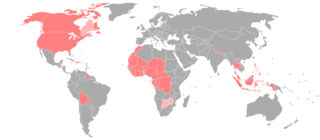
Sign languages are languages that use the visual-manual modality to convey meaning, instead of spoken words. Sign languages are expressed through manual articulation in combination with non-manual markers. Sign languages are full-fledged natural languages with their own grammar and lexicon. Sign languages are not universal and are usually not mutually intelligible, although there are also similarities among different sign languages.
Malaysian Sign Language is the principal language of the deaf community of Malaysia. It is also the official sign language used by the Malaysian government to communicate with the deaf community and was officially recognised by the Malaysian government in 2008 as a means to officially communicate with and among the deaf, particularly on official broadcasts and announcements. BIM has many dialects, differing from state to state.
Hawaiʻi Sign Language, also known as Hoailona ʻŌlelo and Old Hawaiʻi Sign Language, is an indigenous sign language native to Hawaiʻi. Historical records document its presence on the islands as early as the 1820s, but HSL was not formally recognized by linguists until 2013.
Brazilian Sign Language is the sign language used by deaf communities of urban Brazil. It is also known in short as Libras and variously abbreviated as LSB, LGB or LSCB.
Korean Sign Language or KSL is a sign language used for deaf communities of South Korea under the North-South Korean border. It is often referred to simply as 수화; 手話; suhwa, which means signing in general.
Catalan Sign Language is a sign language used by around 18,000 people in different areas of Spain including Barcelona and Catalonia. As of 2012, the Catalan Federation for the Deaf estimates 25,000 LSC signers and roughly 12,000 deaf people around the Catalan lands. It has about 50% intelligibility with Spanish Sign Language (LSE). On the basis of mutual intelligibility, lexicon, and social attitudes, linguists have argued that LSC and LSE are distinct languages.
Singapore Sign Language, or SgSL, is the native sign language used by the deaf and hard of hearing in Singapore, developed over six decades since the setting up of the first school for the Deaf in 1954. Since Singapore's independence in 1965, the Singapore deaf community has had to adapt to many linguistic changes. Today, the local deaf community recognises Singapore Sign Language (SgSL) as a reflection of Singapore's diverse linguistic culture. SgSL is influenced by Shanghainese Sign Language (SSL), American Sign Language (ASL), Signing Exact English (SEE-II) and locally developed signs.
Colombian Sign Language is the deaf sign language of Colombia.
Filipino Sign Language (FSL) or Philippine Sign Language, is a sign language originating in the Philippines. Like other sign languages, FSL is a unique language with its own grammar, syntax and morphology; it is neither based on nor resembles Filipino or English. Some researchers consider the indigenous signs of FSL to be at risk of being lost due to the increasing influence of ASL.
Danish Sign Language is the sign language used in Denmark.
The French Sign Language or Francosign family is a language family of sign languages which includes French Sign Language and American Sign Language.
Armenian Sign Language is the deaf sign language of Armenia.
Saudi Sign Language is the deaf sign language of Saudi Arabia. This sign language is different from the Unified Arabic Sign Language that is used by 18 Arab countries. There are 100,000 deaf people in Saudi Arabia.
Sri Lankan Sign Language is a visual language used by deaf people in Sri Lanka and has regional variations stemming from the 25 Deaf schools in Sri Lanka.
Swiss-German Sign Language is the primary deaf sign language of the German-speaking part of Switzerland and of Liechtenstein. The language was established around 1828. In 2011 it was estimated that 7,500 deaf and 13,000 hearing people use DSGS. There are six dialects which developed in boarding schools for the deaf in Zürich, Bern, Basel, Lucerne, and St. Gallen, as well as in Liechtenstein.
The Japanese Sign Language (JSL) family is a language family of three sign languages: Japanese Sign Language (JSL), Korean Sign Language (KSL), and Taiwanese Sign Language (TSL).
The Swedish Sign Language family is a language family of sign languages, including Swedish Sign Language, Portuguese Sign Language, and Finnish Sign Language.
Bulgarian Sign Language is the language, or perhaps languages, of the deaf community in Bulgaria.

American Sign Language (ASL) developed in the United States and Canada, but has spread around the world. Local varieties have developed in many countries, but there is little research on which should be considered dialects of ASL and which have diverged to the point of being distinct languages.

